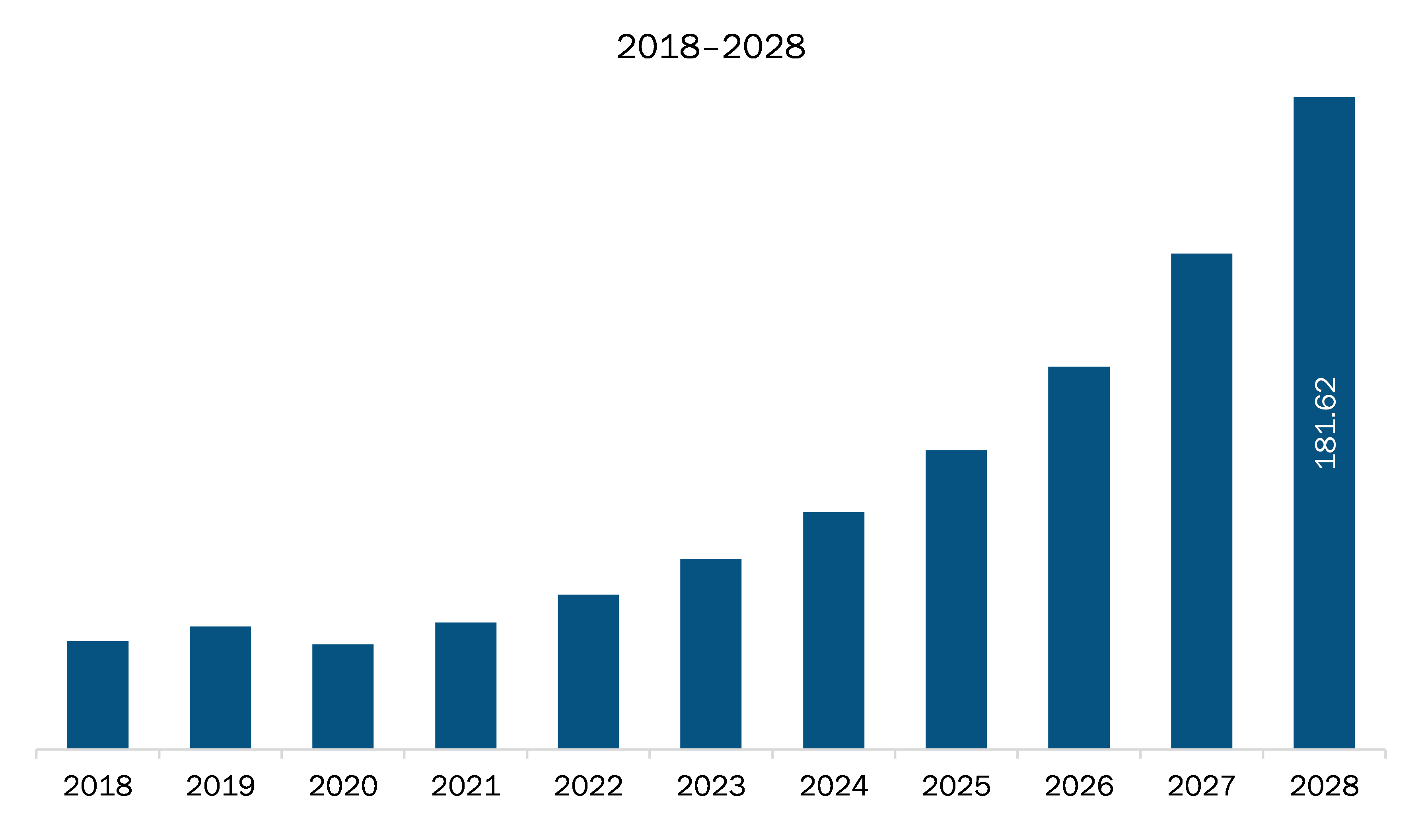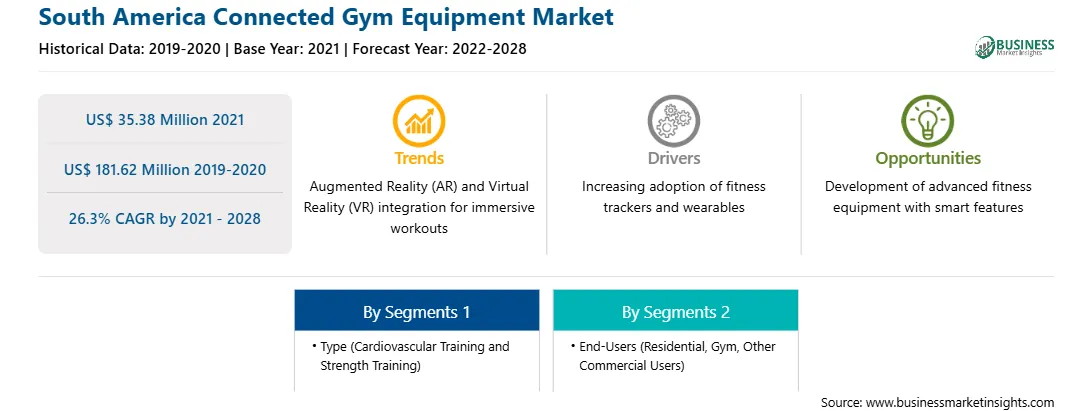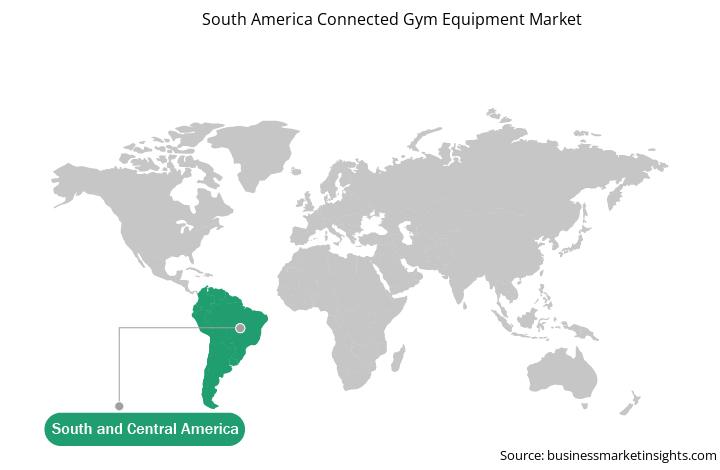The connected gym equipment market is rising rapidly in SAM due to the mounting government support, and the escalating adoption of advanced technologies. The countries in SAM are attracting huge FDIs on the back of cheap labor, and low entry barriers and interest rates. For instance, Argentina is concentrating on attracting FDIs by easing import restrictions, signing international bilateral agreements, and lifting foreign investment restrictions. The rising healthcare costs and growing health consciousness to consume healthy food and participate in regular workouts to remain fit by joining gyms. Thus, such customers are gradually adopting preventive healthcare, that, resulted in an enhanced number of gyms and fitness club in the region. Thus, promoting the growth of the connected gym equipment market in the country. Furthermore, the increasing awareness among millennials and rising expenditure of masses on healthy lifestyle and fitness activities, is boosting them to join gym and fitness clubs that are well equipped with connected equipment’s. Additionally, Gen X are the major consumers of health clubs and gyms, which is forcing the gym owners to focus on continuing to invest in their gym and health memberships by presenting personalized service offerings. Burgeoning technological advancement in connected gym equipment and escalating demand for residential connected gym equipment are the major factor driving the growth of the SAM connected gym equipment market.
In case of COVID-19, SAM is highly affected, especially Brazil. Government authorities in SAM region have taken required actions to protect their people from the infection of COVID-19. Connected gym equipment market has taken a serious hit in the countries like Argentina, Brazil, Chile, and Peru. Since one equipment is used by many people at gym, there are very high chances of spread of corona virus disease. That is why several travel restrictions were imposed. Since gyms are categorized under non-essential services, governments have put serious restrictions on them, and they are facing serious issues from almost a year now. Cardiovascular training and strength training where connected gym equipment are used extensively have experienced sharp decline in the use of these products. The travel bans, factory shutdowns, border lockdowns and import-export restrictions to combat the outbreak of corona virus have impacted the supply, production and sales of various raw material that are needed for the manufacturing of gym equipment. Due to various limitations, the manufacturing of such gym equipment has also declined, resulting in lesser production and procurement. All the mentioned factors have impacted the connected gym equipment market negatively. Because of signs of second and third wave of corona virus cases, it is difficult to predict the future of this market. However, this market seems to have a promising future when situation comes back to normal.

Strategic insights for the South America Connected Gym Equipment provides data-driven analysis of the industry landscape, including current trends, key players, and regional nuances. These insights offer actionable recommendations, enabling readers to differentiate themselves from competitors by identifying untapped segments or developing unique value propositions. Leveraging data analytics, these insights help industry players anticipate the market shifts, whether investors, manufacturers, or other stakeholders. A future-oriented perspective is essential, helping stakeholders anticipate market shifts and position themselves for long-term success in this dynamic region. Ultimately, effective strategic insights empower readers to make informed decisions that drive profitability and achieve their business objectives within the market.

| Report Attribute | Details |
|---|---|
| Market size in 2021 | US$ 35.38 Million |
| Market Size by 2028 | US$ 181.62 Million |
| CAGR (2021 - 2028) | 26.3% |
| Historical Data | 2019-2020 |
| Forecast period | 2022-2028 |
| Segments Covered |
By Type
|
| Regions and Countries Covered | South and Central America
|
| Market leaders and key company profiles |
|
The geographic scope of the South America Connected Gym Equipment refers to the specific areas in which a business operates and competes. Understanding local distinctions, such as diverse consumer preferences (e.g., demand for specific plug types or battery backup durations), varying economic conditions, and regulatory environments, is crucial for tailoring strategies to specific markets. Businesses can expand their reach by identifying underserved areas or adapting their offerings to meet local demands. A clear market focus allows for more effective resource allocation, targeted marketing campaigns, and better positioning against local competitors, ultimately driving growth in those targeted areas.

The SAM connected gym equipment market is expected to grow from US$ 35.38 million in 2021 to US$ 181.62 million by 2028; it is estimated to grow at a CAGR of 26.3% from 2021 to 2028. It is not surprising that technology is increasingly making a place within people’s fitness routines. Consumer mindset is changing, they are not only working out to shape their bodies or to stay fit, but also to enhance their mental health and prevent various infections. The SAM market is observing the launch of new fitness devices, which are technologically innovative and digitally advanced. Market for home connected gym equipment is witnessing significant rise since last few years. Use of fitness apps has grown significantly. Several subscription options are available considering price, timing, and activity for each segment of customer. Fitness trackers are getting modified day by day. Apple has included an electrocardiogram (ECG) function, which provides a more detailed analysis about the users’ heart health. Fitbit’s new watch functions with more advanced heart rate sensors that use algorithms to reveal insights about user’s heart. Virtual coaching and training are becoming a needful tool in today’s fitness world. Several fitness applications are available that help users to simulate the experience of having a personal training class with an instructor by their headphones. So transforming fitness technology is expected to escalate the demand of connected gym equipment, thereby driving the SAM connected gym equipment market during forecast period.
In terms of type, the cardiovascular training segment accounted for the largest share of the SAM connected gym equipment market in 2020. In terms of end-users, the gym segment held a larger market share of the SAM connected gym equipment market in 2020.
A few major primary and secondary sources referred to for preparing this report on the SAM connected gym equipment market are company websites, annual reports, financial reports, national government documents, and statistical database, among others. Major companies listed in the report are Cybex International, Inc.; Johnson Health Tech; LES MILLS INTERNATIONAL LTD; Life Fitness; and Technogym S.p.A.
The South America Connected Gym Equipment Market is valued at US$ 35.38 Million in 2021, it is projected to reach US$ 181.62 Million by 2028.
As per our report South America Connected Gym Equipment Market, the market size is valued at US$ 35.38 Million in 2021, projecting it to reach US$ 181.62 Million by 2028. This translates to a CAGR of approximately 26.3% during the forecast period.
The South America Connected Gym Equipment Market report typically cover these key segments-
The historic period, base year, and forecast period can vary slightly depending on the specific market research report. However, for the South America Connected Gym Equipment Market report:
The South America Connected Gym Equipment Market is populated by several key players, each contributing to its growth and innovation. Some of the major players include:
The South America Connected Gym Equipment Market report is valuable for diverse stakeholders, including:
Essentially, anyone involved in or considering involvement in the South America Connected Gym Equipment Market value chain can benefit from the information contained in a comprehensive market report.